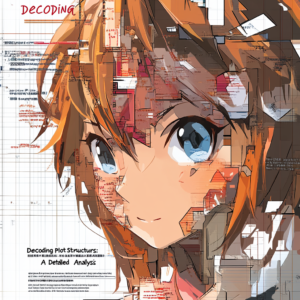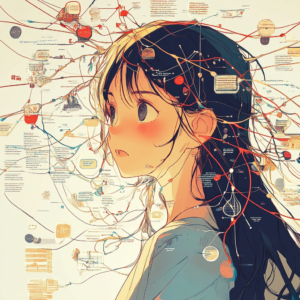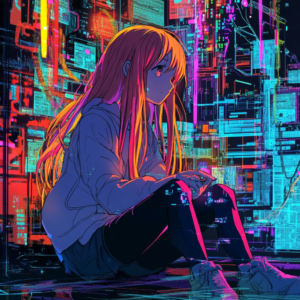1. Introduction
Decoding Anime Plot Structures: A Detailed Analysis is more than just a title—it is an invitation to delve into the intricate narrative frameworks that have defined anime for decades. In this article, we focus on Decoding Anime Plot Structures by exploring how anime plots are constructed, the narrative devices and tropes employed by creators, and the evolution of storytelling techniques that make anime a unique art form. Whether you are a seasoned anime enthusiast or a newcomer eager to understand the mechanics behind your favorite shows, this comprehensive analysis—exceeding 3000 words—provides detailed insights, scholarly perspectives, and practical examples that reveal why Decoding Anime Plot Structures is essential to grasping the full depth of anime storytelling. For additional context on related topics, we invite you to read our in-depth guides on Anime Character Development: Lessons from the Best and Anime Storytelling Techniques: Mastering the Art.

2. Historical Evolution of Anime Plot Structures
The narrative complexity in anime has evolved dramatically since its inception, and understanding Decoding Anime Plot Structures requires an appreciation of this historical progression. Early anime, such as “Astro Boy” and “Kimba the White Lion,” set the groundwork with simple, linear storylines that were designed to be easily understood by a young audience. These early works established a visual and narrative language that emphasized clear moral distinctions and predictable arcs. Despite their simplicity, these series demonstrated the power of visual storytelling and laid the foundation for the genre’s future innovations.
As television and cinema expanded in Japan during the 1960s and 1970s, creators began experimenting with more complex narrative forms. With increased production capabilities and the influence of global artistic trends, anime narratives evolved from straightforward, linear plots into more sophisticated and layered storytelling. This period saw the emergence of experimental techniques such as flashbacks, non-linear timelines, and multiple perspective storytelling, all of which enriched the narrative and allowed for deeper character exploration.
The real turning point came in the 1980s and 1990s with groundbreaking works like Neon Genesis Evangelion and Akira, which challenged conventional plot structures by incorporating psychological depth, philosophical undertones, and abstract symbolism. These series not only redefined the aesthetic of anime but also its narrative possibilities. Modern anime continues this legacy by blending traditional elements with innovative narrative techniques, resulting in stories that are both intellectually stimulating and emotionally resonant. Today, Decoding Anime Plot Structures involves analyzing a rich tapestry of narrative experimentation that mirrors the complexities of contemporary society. For further insights into the cultural evolution of anime, explore resources provided by the Agency for Cultural Affairs of Japan and the Japan Foundation.

3. Key Components of Anime Plot Structures
At the core of Decoding Anime Plot Structures is an understanding of the essential narrative components that define anime storytelling. One of the most important elements is the narrative arc, which typically follows a progression from introduction, through rising action, climax, and resolution. These arcs may be linear or, in many modern works, non-linear—allowing for the integration of flashbacks, foreshadowing, and parallel narratives.
Symbolism plays a pivotal role as well. Anime creators frequently embed layers of meaning into their work through recurring visual motifs, allegorical imagery, and metaphors that encourage viewers to interpret the narrative beyond its surface level. For example, certain colors, objects, or even character names may have symbolic significance that contributes to the overall thematic structure.
Furthermore, character-driven plot devices are crucial in advancing the narrative. In anime, characters are not just vehicles for action; their personal journeys, internal conflicts, and relationships are interwoven with the plot, often driving the story forward in unexpected ways. This integration of character development with plot progression makes the narrative more engaging and multidimensional.
Lastly, modern anime often includes multiple layers of subtext. These hidden messages can address complex themes such as societal issues, philosophical dilemmas, or personal identity. Understanding these subtexts is a fundamental aspect of Decoding Anime Plot Structures, as it reveals the depth and nuance of the storytelling.
Together, these components form the backbone of anime narratives and are essential to understanding how intricate plot structures are crafted to captivate and challenge viewers.
4. Structural Archetypes in Anime Narratives
Anime plot structures frequently adhere to certain archetypes that provide a familiar framework while also allowing for creative subversion. One of the most prominent archetypes is the hero’s journey, where the protagonist embarks on a transformative quest, facing various trials and ultimately achieving personal growth. However, many modern anime choose to deconstruct or twist this archetype to introduce darker themes and more ambiguous endings.
Another common archetype is the tragic hero, whose downfall is intertwined with personal sacrifice and existential conflict. This archetype often explores themes of fate, destiny, and the inherent imperfections of humanity.
Additionally, anime frequently features anti-heroes and complex villains whose moral ambiguity challenges traditional notions of good versus evil. These characters add layers of complexity to the narrative, inviting viewers to question their assumptions about justice and redemption.
Some anime also experiment with non-linear and fragmented storytelling, using flashbacks, parallel narratives, or meta-commentary to disrupt conventional narrative flow. This experimental approach forces the audience to actively piece together the storyline, enhancing the overall engagement and interpretative experience of Decoding Anime Plot Structures.
These archetypes not only guide the narrative but also provide a foundation for subversion and innovation, allowing anime creators to push the boundaries of conventional storytelling.
5. Case Studies: Classic and Modern Examples
To truly understand Decoding Anime Plot Structures, it is essential to examine specific examples from both classic and modern anime. These case studies reveal how different narrative techniques are employed and how they evolve over time.
5.1 Classic Example: Neon Genesis Evangelion
Neon Genesis Evangelion is widely recognized for its groundbreaking approach to storytelling. Its narrative defies traditional linearity by interweaving psychological drama, religious symbolism, and existential philosophy. The series uses fragmented storytelling and ambiguous plot twists to create a narrative that is both deeply personal and broadly symbolic. This complex structure invites viewers to engage in continuous reinterpretation, making it a quintessential example of Decoding Anime Plot Structures.
5.2 Modern Example: Attack on Titan
Attack on Titan offers a modern take on narrative complexity. Its plot is built on suspense, with carefully placed cliffhangers and sudden revelations that gradually unveil a dystopian world filled with political intrigue and historical mysteries. The non-linear narrative and strategic use of flashbacks enrich the storytelling, compelling viewers to piece together the overarching plot from scattered clues. This approach exemplifies how modern anime use complex structures to create immersive and thought-provoking narratives.
5.3 Contemporary Experimentation: Puella Magi Madoka Magica
Puella Magi Madoka Magica deconstructs the magical girl genre by introducing unexpected dark twists and existential themes. Its narrative subverts the expectations of its genre, presenting a storyline that is both visually stunning and thematically challenging. The series’ innovative plot structure, marked by dramatic reversals and layered subtext, serves as a powerful case study for Decoding Anime Plot Structures and highlights the potential for narrative innovation within anime.
5.4 YouTube Resource for In-Depth Analysis
For those who wish to explore these case studies further, this high-quality YouTube video provides an in-depth look at the narrative techniques used in anime like Evangelion and Attack on Titan. The video breaks down the digital tools and storytelling devices that contribute to the rich complexity of modern anime plots, offering valuable insights that complement this analysis.
6. Comparative Analysis: Decoding Anime Plot Structures vs. Traditional Narratives
A comparative analysis reveals significant differences between traditional narrative forms and the complex structures found in modern anime. Traditional storytelling often follows a linear progression, with a clear beginning, middle, and end. In contrast, many contemporary anime employ non-linear structures, multiple timelines, and layered subtexts that challenge the viewer’s perception of time and causality.
6.1 Linear vs. Non-Linear Storytelling
Traditional narratives typically offer a straightforward progression of events, making them easy to follow but sometimes lacking in depth. Modern anime, however, frequently break this mold by presenting fragmented narratives that require active interpretation. This non-linear approach not only deepens the emotional impact of the story but also engages viewers in a dynamic process of decoding and analysis.
6.2 Integration of Symbolism and Subtext
While traditional storytelling might use symbolism sparingly, modern anime infuse nearly every frame with visual and thematic cues. This constant interplay of overt and covert messages compels audiences to look beyond the surface narrative, fostering a richer understanding of the underlying themes. Such integration of symbolism is a key element in Decoding Anime Plot Structures and is instrumental in transforming the viewing experience into an interactive analytical journey.
6.3 Viewer Engagement and Interpretation
The shift towards complex narrative structures has a profound effect on viewer engagement. Audiences are no longer passive consumers; they become active participants in piecing together the storyline, analyzing character motivations, and debating the significance of symbolic elements. This level of engagement not only enhances the overall impact of the narrative but also reflects a broader trend in modern media consumption, where interactivity and analysis are highly valued.
7. The Impact of Anime Plot Structures on the Industry
Understanding Decoding Anime Plot Structures is not only an academic exercise—it has real-world implications for the anime industry.
7.1 Influencing Storytelling Techniques
The evolution of plot structures has spurred a new wave of creativity among anime creators. By experimenting with non-linear narratives, layered subtexts, and innovative character arcs, modern anime have set new benchmarks for storytelling. This evolution influences not only the creative process but also the production and marketing strategies of studios, as they seek to meet the demands of an increasingly discerning audience.
7.2 Shaping Audience Expectations
As viewers become more adept at deciphering complex narratives, their expectations for future anime evolve accordingly. The success of series that employ innovative plot structures pushes the industry to continuously refine and expand its narrative techniques. This dynamic interplay between audience expectations and creative innovation is a driving force behind the ongoing transformation in anime production.
7.3 Market and Cultural Impact
The intricate plot structures of modern anime have contributed significantly to the medium’s cultural impact. By offering stories that challenge conventional norms and provoke thoughtful discussion, anime have carved out a unique space in global pop culture. This influence extends beyond entertainment, impacting academic research, cultural studies, and even inspiring new forms of art and media.
8. Future Trends in Anime Plot Structures
Looking ahead, the evolution of anime plot structures promises to continue pushing the boundaries of storytelling and innovation.
8.1 Emerging Narrative Innovations
Advancements in digital technology, such as AI-assisted animation and interactive storytelling platforms, will pave the way for even more complex narrative frameworks. Future anime may integrate real-time viewer feedback into their story arcs, creating a dynamic interplay between the narrative and the audience. This evolution will further complicate the process of Decoding Anime Plot Structures, offering a more immersive and participatory experience.
8.2 Fusion of Global Cultural Narratives
As anime becomes an even more global phenomenon, its plot structures will likely reflect a fusion of diverse cultural narratives. Future series may blend traditional Japanese storytelling with elements from Western, African, and Latin American cultures, creating hybrid narratives that appeal to an international audience. This cross-cultural integration will enrich the narrative complexity and broaden the appeal of anime, reinforcing its role as a global cultural force.
8.3 Increased Use of Non-Linear and Meta-Narratives
The trend towards non-linear storytelling is expected to intensify, with future anime employing multiple timelines, meta-commentaries, and self-referential narratives that challenge conventional plot progression. These techniques will not only enhance the depth of the narrative but also encourage viewers to engage in active interpretation, making the process of Decoding Anime Plot Structures even more interactive and intellectually stimulating.
8.4 Expansion of Interactive Digital Platforms
The rise of interactive digital platforms will transform how anime narratives are experienced. Virtual reality (VR), augmented reality (AR), and real-time interactive streaming will allow viewers to immerse themselves in anime worlds like never before. These technologies will enable personalized narrative experiences, where the audience can influence story outcomes. Such innovations will further blur the line between creator and consumer, heralding a new era of participatory storytelling that will redefine Decoding Anime Plot Structures for the next generation.
9. Conclusion
In conclusion, Decoding Anime Plot Structures: A Detailed Analysis offers a comprehensive exploration of the intricate narrative frameworks that define anime. We have traced the historical evolution of anime plot structures, examined the key components and structural archetypes that shape these narratives, and delved into case studies from classic to modern works that exemplify innovative storytelling techniques. Our comparative analysis highlighted the differences between traditional linear narratives and the complex, multi-layered structures prevalent in contemporary anime, while our discussion on industry impact and future trends demonstrated how these narrative innovations continue to shape the medium.
Thank you for reading this extensive analysis. Stay tuned for more exclusive content and updates as we continue to explore the transformative power of anime storytelling. The journey through Decoding Anime Plot Structures is just beginning, and the future holds endless possibilities for innovation, creativity, and cultural evolution.

10. Frequently Asked Questions (FAQ)
Q1: What does “Decoding Anime Plot Structures” mean?
A: It refers to the process of analyzing and understanding the narrative frameworks and techniques used in anime to construct complex, multi-layered stories.
Q2: Why is it important to decode anime plot structures?
A: Decoding anime plot structures helps viewers appreciate the intricacies of storytelling, reveals hidden meanings, and enhances overall engagement with the medium.
Q3: What are some common elements found in anime plot structures?
A: Common elements include narrative arcs, symbolism, thematic motifs, character-driven plots, and experimental non-linear storytelling techniques.
Q4: How have modern technologies influenced anime plot structures?
A: Advances in digital animation, CGI, and interactive media have allowed for more complex storytelling techniques, enabling creators to experiment with narrative forms and engage audiences in new ways.
Q5: Where can I learn more about anime storytelling techniques?
A: For further insights, explore related guides on MeadTavern.com, such as Anime Character Development: Lessons from the Best and Anime Storytelling Techniques: Mastering the Art.
If you’re interested in diving deeper into veganism, explore this comprehensive guide that walks you through every step with video tutorials, downloadable resources, and expert insights. Check it out here: https://go.hotmart.com/N99489766N
